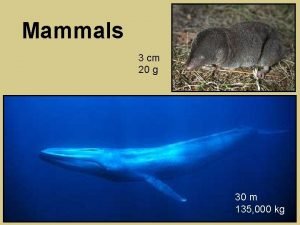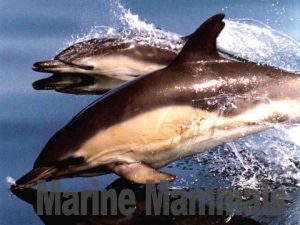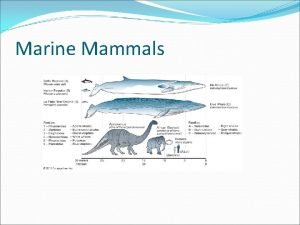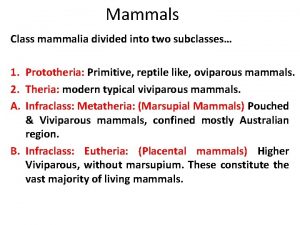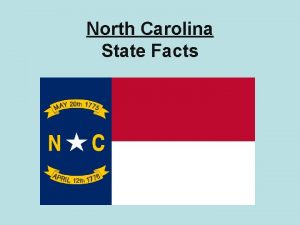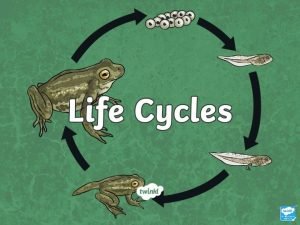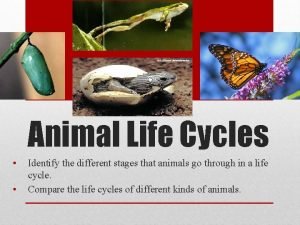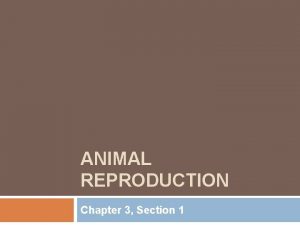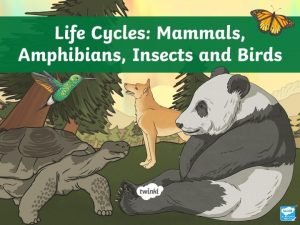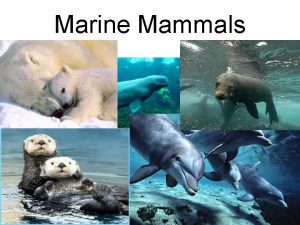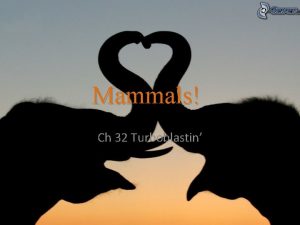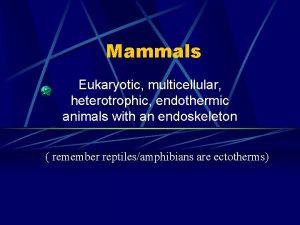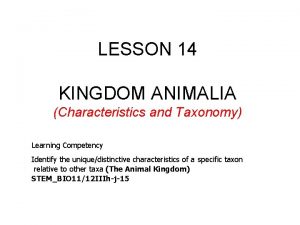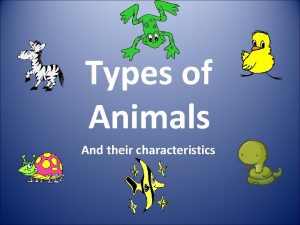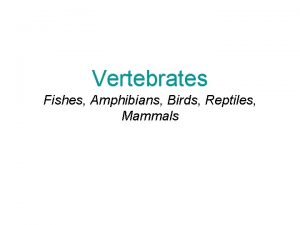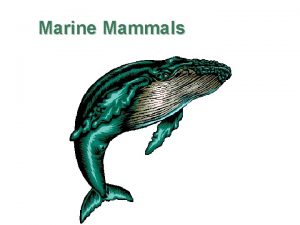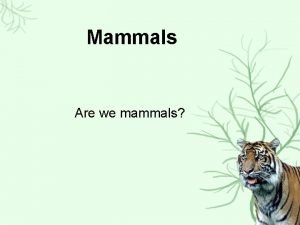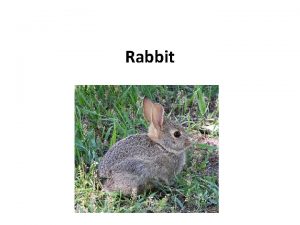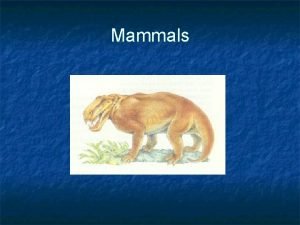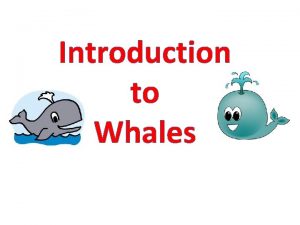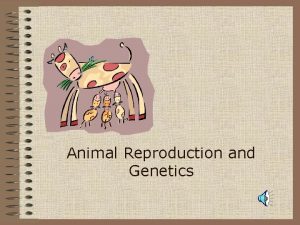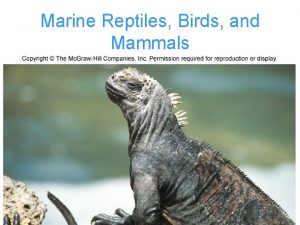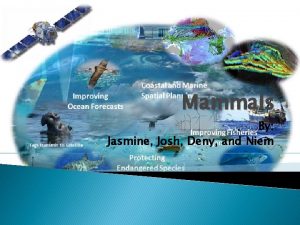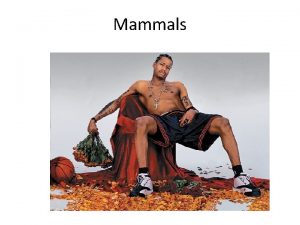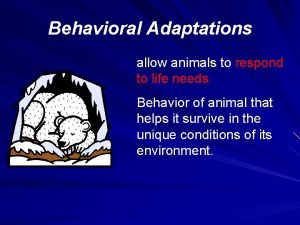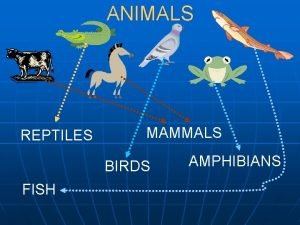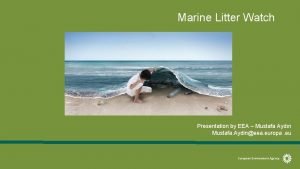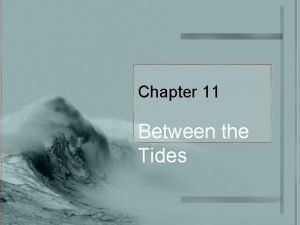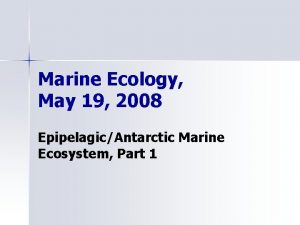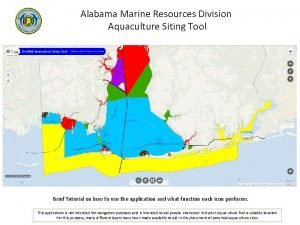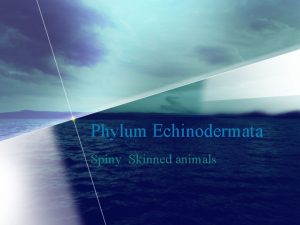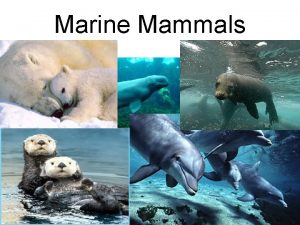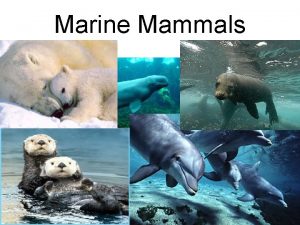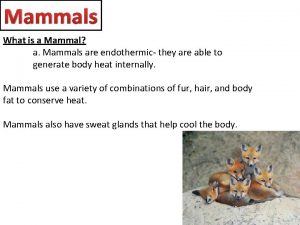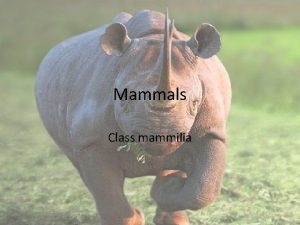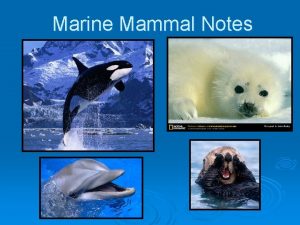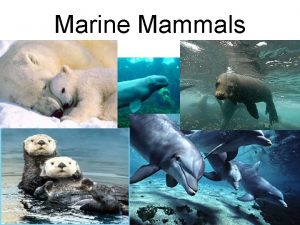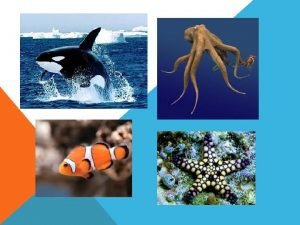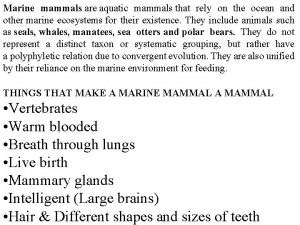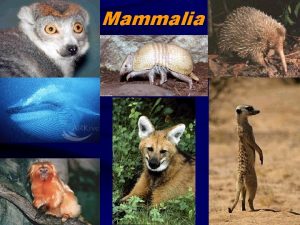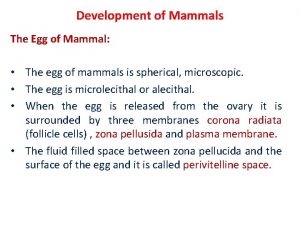Marine Mammals Marine mammal A marine mammal is























































































- Slides: 87

Marine Mammals


Marine mammal • A marine mammal is a mammal who lives in a marine environment (or in some cases an aquatic environment) and obtains all or most of its food there.

What does it mean to be a mammal? 1. They have lungs and breath air. 2. They are warm blooded and maintain a constant body temperature. 3. Most give birth to live young. One primitive mammal group, the Monotremes (which includes the duckbill platypus and the echidna) lays eggs. 4. They produce milk and nurse their young. 5. They have hair at some point in their lives.

Name some marine mammals:

• For animals that live in the seas and oceans, those that meet all five criteria certainly include seals, sea lions, walruses, sea otters, polar bears and manatees. But what about dolphins, whales and porpoises? Hair? Yes, very early in life these animals posses hair around their mouths which are usually lost soon after birth.

There four general types of marine mammals 1. Cetaceans - whales, dolphins and porpoises 2. Pinnipeds - seals, sea lions and walruses 3. Sirenians - dugongs and manatees 4. Carnivores - sea otters and polar bears

Cetaceans - whales, dolphins and porpoises


Pinnipeds - seals, sea lions and walruses

Sirenians - dugongs and manatees • While manatees have a paddleshaped tail. the dugongs have a tail that is pointed on the ends, very much like a whale's.


Whales and Dolphins Orca (Killer whale) Bottlenose dolphin

Carnivores - sea otters and polar bears

1. CETACEA • Whales and Dolphins come from the same family, CETACEA (sey-tay-sha) • There about 80 kinds of whales and dolphins that we know of right now.

What do whales and dolphins have in common? • They both breath from a blowhole located at the top of their head. Minke whale

Whales and dolphins are mammals They are mammals because they have: • lungs not gills • they have hair not scales • they also give live birth and don't lay eggs.

• There are two major groups of whale: 1. Toothed whales (suborder Odontoceti) 2. Baleen whales (toothless) (suborder Mysticeti). orca

Toothed Whales • Toothed whales include several families a) the beaked and bottlenose whales (family Ziphiidae) b) the sperm whale (family Physeteridae); Point of interest: • The white whale Moby-Dick, of Herman Melville's novel, was not a beluga but an albino sperm whale

Bottlenose whale

Beaked whale

Sperm Whales have the largest "nose" in the animal kingdom. The nose contains an oil filled case which scientists believe the animal uses to produce and focus sound

c) the beluga, or white whale, and the narwhal (family Monodontidae), narwhal

beluga

beluga



d) small polar whales with no dorsal fin and only a few teeth; the river dolphins (family Platanispidae), River dolphins inhabit muddy rivers of India and South America;

River dolphin

e) ocean dolphins and porpoises (there are several families), the killer whale and pilot whale are types of dolphins.



Pilot whales Killer whale

Echolocation • Many species use echolocation (sonar) for underwater navigation and hunting. They have a single blowhole and a wide throat to accommodate large prey.

Toothless Whales There are three families of baleen whales 1) The right whale family (Balaenidae), including the bowhead, or Greenland whale;



We can now use radio telemetry to find out where whales go…

The North Atlantic Right whale’s north-south migration between calving and feeding grounds hugs the coast, setting up dangerous intersections with intensive east-west ship traffic through busy East Coast ports. Ship collisions are a major factor causing the right whale’s population decline.

2) the gray whale family (Eschrichtidae), with a single species (Eschrichtius robustus) found in the North Pacific Ocean;



3) the rorqual family (Balaenopteridae) This group includes: • humpback whale • sei whale • minke whale • Bryde's whale • the fin whale (or common rorqual) • the blue whale (which can grow to a length of 100 ft (30 m) and a weight of 150 tons)

humpback

Dwark minke whale

humpback

Sei whale

Fin whale

Bowhead whale

Baleen Plates

Baleen Plates • Baleen whales use their mouth as a giant strainer. • The upper jaw is lined with bony plates called baleen that hang vertically like vertical blinds. • The spaces between the plates are small allowing water to pass through, but not the food. • The whale swims through the schools of fish with its mouth open taking in both fish and water. The throat pleats expand to make more room. • Then the whale closes its mouth and pushes the water out through the baleen plates trapping the fish inside to be swallowed.

• Toothless whales are large species, usually over 33 ft (10 m) long. • They are filter feeders, living on shrimplike krill, plankton, and small fish. • They lack teeth but have brushlike sheets of a horny material called baleen, or whalebone, edging the roof of the mouth

Blue Whales are the largest to have ever lived on the planet at a recorded length of more than 110 feet and a weight of around 190 tons


Pinnipeds • “winged feet" • aquatic mammals that use flippers for movement on land in the water • they are carnivores • All pinnipeds must come ashore to breed, give birth, and nurse their young

Three families of living pinnipeds are recognized: 1. Earless seals or true seals (Phocidae) 2. Eared or fur seals and sea lions (Otaridae) 3. Walruses (Odobenidae)

SEALS: • Do not have an ear that extends from the skull, but they can still hear well. • Propel themselves through the water with their rear flippers. • Front flippers are used for steering. • The front flippers of seals are short with sharp claws. Seals cannot use their rear flippers to walk on land or ice and most appear awkward when moving on these surfaces. • Seals have a torpedo like shape in the water and use their rear flippers to move rapidly to catch prey and escape predators.

Largha (spotted) seal

Crabeater seals

Crabeater seal skull with blowup of the special teeth that are used to filter the krill from the water

Ribbon seal

Harbor seal

Spotted seal

Sea Lions and Fur Seals • Fur seals and sea lions have ears that extend from the skull. The front flippers of fur seals and sea lions are used to propel them through the water. • Sea lions have a rounded snout and their fur is courser and shorter than a fur seal. • Sea lions are the larger of the two. • Fur seals have a longer, pointer snout, their fur is longer and finer, and their flippers are longer.

Steller sea lion

Northern fur seal pup

Northern Fur Seal pup

Steller Sea Lion pups

Northern Fur Seal Bull. Notice thick fur, the fur is thick enough that it is waterproof

Galapagos Sea Lion

Walrus The Walrus lives in the Arctic circle and spends much of its day in open water or near the shore resting on ice floes

Sometimes the blubber on a walrus will be over 6 inches deep to keep the animal from freezing to death

Sirenians-Manatees and Dugongs • Sirenians spend their whole lives in water. • Manatees are aquatic mammals that are called sea cows (named this by Georg Wilhelm Steller, because they taste like beef). • These plant eaters are slow swimmers; they have two flippers, each of which has three to four nails on the end (there are no external hind limbs). • Short whiskers adorn the short, boxy snout. • Manatees are closely related to the elephant

• Manatees migrate along the coast. North American manatees winter in Florida, as they prefer warm water. Amazonian manatees

Antillean manatee

Florida manatee

Dugongs • The dugong lives in the shallow water of tropical seas off the coasts of East Africa, Australia, India, the Phillippines, and other islands in the South Pacific. • Dugongs look different from manatees. • Dugongs have pointed tails ( many manatees have a small notch in the tail) and one pair of tusk-like teeth. • Dugongs are seldom found in fresh water.

Dugong • Dugongs rest in the deep water during the day and move towards the shoreline at night to feed. The dugong uses its flippers for balance and moving along the ocean floor as it grazes. Dugongs are not thought to migrate as far as the manatees do. Like manatees, dugongs are usually found in small groups are alone. But groups of thousands of dugongs have been seen occasionally.

dugong or sea cow

dugong or sea cow

Other Marine mammals • Two species that are also considered marine mammals are the Northern Pacific sea otter and the South American sea otter. • Sea otters are notable because they are the only marine mammal species that use tools to forage for food.

Sea otter

Sea otter

Polar bear • The polar bear is also considered a marine mammal because it is a proficient swimmer, which hunts primarily on sea ice for ringed and bearded seals

Polar bears… marine mammals unique to the waters of the circumpolar Arctic, and is found in the wild in five countries: Canada, Greenland (territory of Denmark), Norway, the USA, and the former USSR, as well as on the high seas where jurisdiction is not clearly defined.

current wild population of Polar bears is estimated to be between 21, 000 and 28, 000 individuals.

The average land Polar bear is 2. 5 to 3 metres long. Males grow to 2 or 3 times the size of females.
 Vertebrates and invertebrates classification
Vertebrates and invertebrates classification Pelycosaurs
Pelycosaurs Mucrus
Mucrus 10 characteristics of mammals
10 characteristics of mammals Amazonian manatee adaptations
Amazonian manatee adaptations Characteristics of marine mammals
Characteristics of marine mammals Arkansas state mammal
Arkansas state mammal Mammal subclasses
Mammal subclasses What is nc state bird
What is nc state bird Mamals life cycle
Mamals life cycle Features of mammals
Features of mammals Characteristics of carnivores
Characteristics of carnivores Mammal life cycle stages
Mammal life cycle stages Mammal reproduction
Mammal reproduction Mammal life cycle
Mammal life cycle Platypus a mammal or reptile
Platypus a mammal or reptile Mammal subclasses
Mammal subclasses What is a mammal
What is a mammal If an animal has hair then it is a mammal. (converse)
If an animal has hair then it is a mammal. (converse) What us a mammal
What us a mammal فسيولوجي
فسيولوجي Dental formula in mammals
Dental formula in mammals Some bacteria benefit mammals by helping with
Some bacteria benefit mammals by helping with What animal is that
What animal is that Monetremes
Monetremes The eutherian mammals for plantigale is patagonian cavy
The eutherian mammals for plantigale is patagonian cavy The mcgraw-hill
The mcgraw-hill Light can travels from the sun to the earth
Light can travels from the sun to the earth Types of animals and their characteristics
Types of animals and their characteristics Excretory organs in mammals
Excretory organs in mammals Chapter 30 section 2 diversity of mammals
Chapter 30 section 2 diversity of mammals Cheetah cladogram
Cheetah cladogram Echolcation
Echolcation Mammals
Mammals Alimentary canal of mammals
Alimentary canal of mammals Marsupils
Marsupils About mammals
About mammals Introduction of mammals
Introduction of mammals Ocean currents project
Ocean currents project Homeostasis in mammals
Homeostasis in mammals Text derek
Text derek Rabbits are small mammals in the family
Rabbits are small mammals in the family Class mammalia characteristics
Class mammalia characteristics All mammals have hair. its main purpose is to
All mammals have hair. its main purpose is to Mammals animals
Mammals animals Are birds mammals
Are birds mammals Chapter 30 section 1 mammalian characteristics answer key
Chapter 30 section 1 mammalian characteristics answer key Characteristic of whale
Characteristic of whale 32-1 introduction to mammals
32-1 introduction to mammals Male reproductive system of mammals
Male reproductive system of mammals Hair as evidence
Hair as evidence What are some special characteristics
What are some special characteristics Parthenogenesis in mammals
Parthenogenesis in mammals Dorsal fin with spines
Dorsal fin with spines Mammals
Mammals Behavioral adaptations of a hawk
Behavioral adaptations of a hawk Amphibians reptiles mammals birds fish
Amphibians reptiles mammals birds fish Section 32-1 introduction to the mammals
Section 32-1 introduction to the mammals Characteristics of mammals
Characteristics of mammals Starting air system
Starting air system Scope of marine insurance
Scope of marine insurance Crm for the marine industry
Crm for the marine industry Join hands marine services private limited
Join hands marine services private limited Marine litter watch
Marine litter watch Wave shock marine biology
Wave shock marine biology Mcdp1 defines trust as a product of which of the following
Mcdp1 defines trust as a product of which of the following Marine fishes
Marine fishes Marine geospatial ecology tools
Marine geospatial ecology tools Marine ot desing
Marine ot desing Us marine corps university
Us marine corps university Bergstrm
Bergstrm Marine couverchel
Marine couverchel Marine ecology
Marine ecology Maritime erp integration
Maritime erp integration Sea and marine otters belong to the order carnivora.
Sea and marine otters belong to the order carnivora. Duckster.com science
Duckster.com science Chapter 52: an introduction to ecology and the biosphere
Chapter 52: an introduction to ecology and the biosphere Alabama marine resources
Alabama marine resources Itk inseneribüroo
Itk inseneribüroo Tokiocorretor
Tokiocorretor Aydin marine
Aydin marine Marine electronic highway
Marine electronic highway Marine creature
Marine creature Pay grade marine corps
Pay grade marine corps Caribbean large marine ecosystem
Caribbean large marine ecosystem Phylum with spiny skin
Phylum with spiny skin Kingdom plantae vascular and nonvascular
Kingdom plantae vascular and nonvascular West coast national park marine protected area
West coast national park marine protected area

